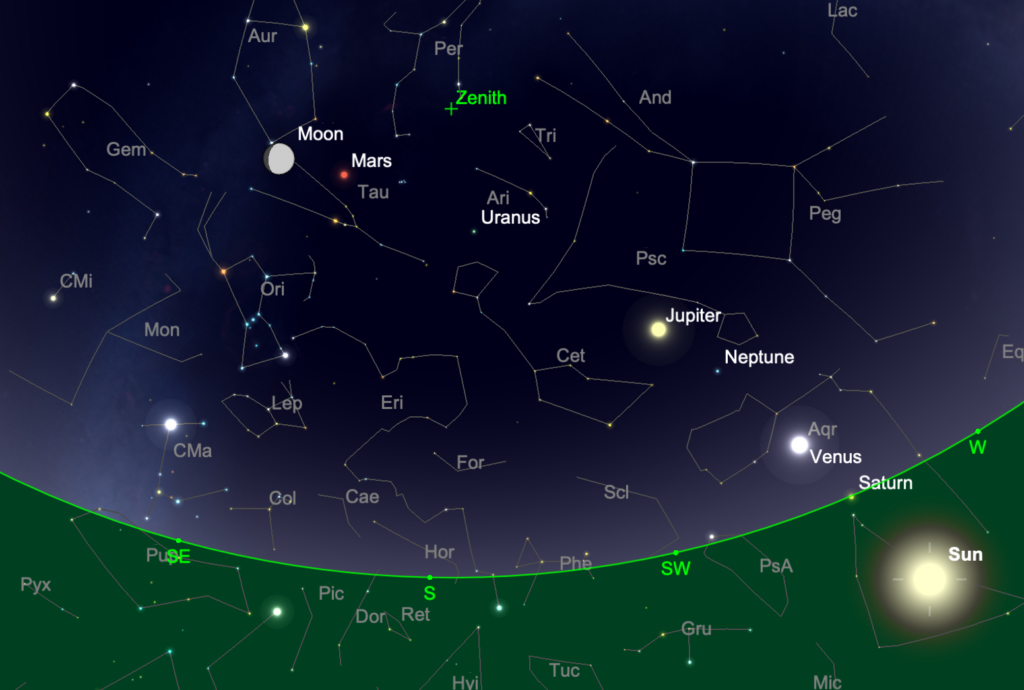Sky Report: January 30 – February 5

The sky one hour after sunset on the 31st . The horizon is transparent so you can see the sun, and incidentally the stars. Graphic created with SkySafariAstronomy.com.
Here’s more on the “green” comet presently in the evening sky. Comet C/2022 E3 passed closest to the sun (103 million miles) on January 12 and to the earth (26 million miles) on February 1, and then it begins to fade. At best it was *barely* visible to the naked eye under the darkest of skies and more easily in binoculars if you knew precisely where to look, and then it was a little fuzzball with a bright center and nothing like the photographs in books. And no, it doesn’t look green, at least not to your eye.
Although the comet is nicely placed for early evening viewing above the north star and eventually high overhead, the moon will be so bright that it will make it a true challenge to find it. If you want to try, find the comet’s position by searching the web or better yet with planetarium software. Note that the comet is moving rapidly across the sky at the fantastic rate of 12° per day, or ½° per hour, so with a telescope you can actually watch it move against the background of stars. This is highly unusual; I’ve watched a solar system object actually move only a few times in my life. Also note that it passes less than 2° from the bright star Capella on the 5th and a similar distance from Mars on the 10th.
Seven more comets are predicted to come within the range of backyard telescopes in 2023, but none to the naked eye. Each will be treated in turn in future Sky Reports.
Turning to planets, this week four are readily visible and a fifth is theoretically visible, but in practice you’re unlikely to find it. That fifth planet is Saturn which sets one hour after the sun. If the air is perfectly clear and you have a flat horizon and binoculars you might spot it a few degrees above the horizon a half-hour after sunset, but Saturn is for observers who like challenges.
Venus too was close to the sun a few weeks ago, but it’s slowly climbing higher night by night and now it sets a full two hours after the sun. Its great brilliance makes it a beautiful sight low in the west to the eye and binoculars; unfortunately there’s not much to see with a telescope except a small, featureless nearly round (nearly full) disk.
Bright Jupiter is 30° above and slightly to the left of Venus and it too is conspicuous in a part of the sky that is empty of bright stars to compete. These are the final days to see Jupiter’s cloud markings in a telescope as it sets 4 minutes earlier each night and is closer to the horizon, seen through denser and more turbulent layers of our atmosphere.
Neptune, by the way, is midway between Venus and Jupiter.
Mars is twice as far from Jupiter as Jupiter is from Venus, and the three clearly define the ecliptic, the plane of the solar system. Mars is in Taurus some 8° above the star Aldebaran, and the two share their orange color – orange in the case of Aldebaran due to the star’s relatively cool temperature and in the case of Mars to oxidized (rusted) minerals in its crust. Mars has faded substantially from last fall when it was closer to the earth, but it still outshines all the stars but Sirius.
On January 30th Mars sits just 1°, or two moon-diameters, from the waxing gibbous moon and you’ll easily see the two together in any binoculars and even wide-angle telescopes.
Last is little Mercury, now in the morning sky where it rises in the northeast 90 minutes before the sun. It’s brighter than any nearby star. It’s in Sagittarius, and it can be a novelty to see such a summer constellation in February’s sky.
The Sky Report is presented as a public service by the Stellar Vista Observatory, a nonprofit organization based in Kanab, Utah, which provides opportunities for people to observe, appreciate, and comprehend our starry night sky. Additional information is at www.stellarvistaobservatory.org. Send questions and comments to John@StargazingAdventures.org.






Comments are closed.